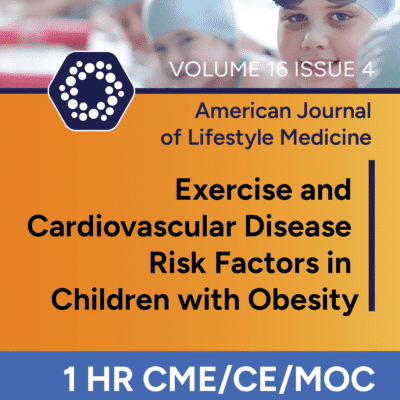Learning Objectives:
- Discuss cardiovascular disease risk factors in children and adolescents that are improved by exercise
- Recall the number of minutes of daily exercise recommended for children with obesity
- Classify the risk of bias associated with studies in this meta-analysis
- Differentiate the cardiometabolic parameters that are improved with aerobic versus combined aerobic and strength training exercise

“This course adds context to the patient-clinician lifestyle medicine appointment by providing clearer information regarding the benefits of exercise in children and adolescents with obesity, including general guidelines for achieving such. This CME also reinforces the importance of referring children and adolescents with obesity to certified exercise programming professionals.”
George A. Kelley, DA, FACSM
Exercise and Cardiovascular Disease Risk Factors in Children and Adolescents With Obesity: A Systematic Review With Meta-Analysis of Randomized Controlled Trials
The purpose of this study was to examine the effects of exercise on cardiovascular disease (CVD) risk factors in children and adolescents with obesity. Randomized controlled trials (RCTs) of exercise ≥4 weeks in children and adolescents with obesity were included if one or more CVD risk factors were included as an outcome.
Studies were retrieved by searching 7 electronic databases, cross-referencing, and expert review. Data were pooled using the inverse-variance heterogeneity (IVhet) model and strength of evidence was assessed using the Grading of Recommendations Assessment, Development and Evaluation (GRADE) instrument. Thirty-nine studies representing 1548 participants (847 exercise, 701 control) met the inclusion criteria. Aerobic exercise improved 10 of 12 (83.3%) outcomes (P < .05 for all) while combined aerobic and strength training improved 5 of 8 (62.5%) outcomes (P < .05 for all). The strength of evidence ranged from “very low” to “moderate.”
It was concluded that aerobic exercise, as well as combined aerobic and strength training, is associated with improvements in multiple CVD risk factors among children and adolescents with obesity. However, the generally low strength of evidence suggests a need for future well-designed and conducted RCTs on the effects of exercise, especially strength training, in children and adolescents with obesity.
This learning activity consists of one AJLM article and one quiz.
Duration: 1 hour
Assessment and Measurement: A score of 80% or higher on the quiz is required to pass the learning activity.
Specifications: This course can be viewed on desktop, tablet or mobile device.
Term of Approval: August 1, 2022 – August 1, 2025
Participant User Agreement (Terms of Use and Copyright): Before registering for a Continuing Education/Continuing Medical Education Course (“Training”) for the first time, carefully review the following conditions of usage at https://lifestylemedicine.org/terms-of-use-and-copyright-cme-ce/.
Registering for an American College of Lifestyle Medicine Course indicates your acceptance of the Participant User Agreement and its terms and conditions.
Enrollment: Access to online material is granted through the term of approval which ends August 1, 2025.
Accreditation Statement:
In support of patient care, Rush University Medical Center is jointly accredited by the American Nurses Credentialing Center (ANCC), the Accreditation Council for Pharmacy Education (ACPE), and the Accreditation Council for Continuing Medical Education (ACCME) to provide continuing education for the healthcare team.
Designation Statement:
Rush University Medical Center designates this enduring material for a maximum of 1.0 AMA PRA Category 1 Credit(s)™. Physicians should claim only credit commensurate with the extent of their participation in the activity.
Rush University Medical Center designates this enduring material activity for a maximum of 1.0 nursing contact hour.
This activity is being presented without bias and without commercial support.
Rush University Medical Center designates this knowledge-based enduring material for a maximum of 1.0 contact hour for pharmacists.
Rush University Medical Center designates this knowledge-based enduring material for 1.0 CE credit in psychology.
Rush University is an approved provider for physical therapy (216.000272), occupational therapy, respiratory therapy, social work (159.001203), nutrition, speech-audiology, and psychology by the Illinois Department of Professional Regulation.
Rush University designates this enduring material for a maximum of 1.0 continuing education credit for physical therapists, occupational therapists, respiratory therapists, social workers, nutritionists, speech pathologists, audiologists, and/or psychologists.
This activity has been approved by The Commission on Dietetic Registration for 1 CPEUs.
The American Board of Lifestyle Medicine has approved 1.0 maintenance of certification credit for this learning activity.

